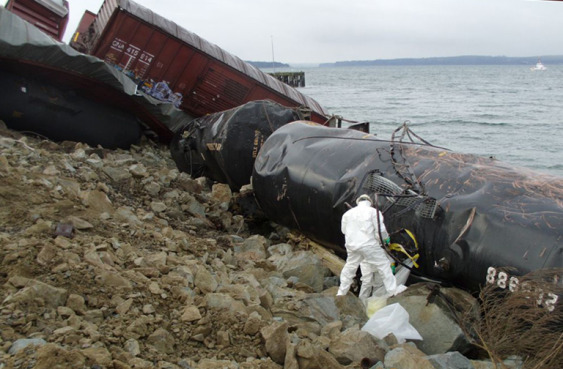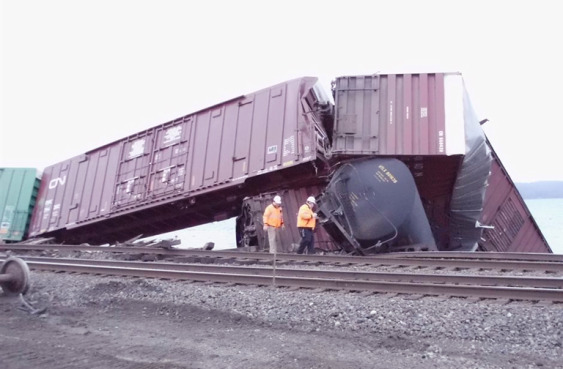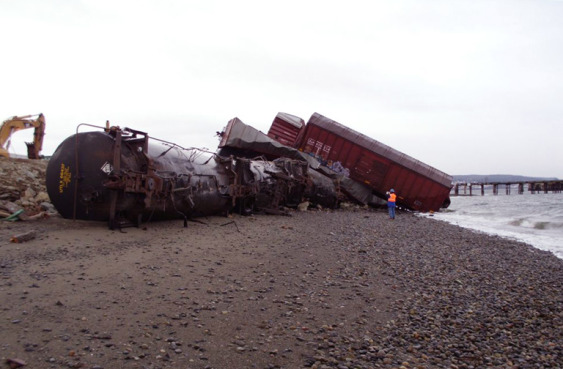If you’ve ever wondered how an oil train derailment might go down on the shores of Puget Sound, it might look a bit like the winter night derailment in 2011 that spilled sodium hydroxide on a beach at Chambers Bay south of Tacoma. It was hardly the kind of disaster that has resulted from oil trains derailing, but it still makes for a rather instructive lesson in how these things happen.
Sodium hydroxide, more commonly known as lye, is used as a chemical base in the production of pulp and paper, textiles, drain cleaners, and other products. (It’s also the major ingredient that makes lutefisk unpalatable.) It’s caustic, corrosive to metal and glass, and it can cause fairly serious burns. You want to be careful handling it but—notably unlike the volatile shale oil traveling daily on the very same rail line—it does not erupt into 300-foot-tall fireballs.
If it had been an oil train, things could have been much, much worse.
What happened is this: around 8 pm on February 26, 2011, a north-bound freight train derailed, sideswiping a south-bound train that was carrying (among other things) four loaded tank cars of sodium hydroxide in a liquid solution. One of those cars was damaged in the collision and leaked a relatively modest 50 gallons onto the beach before response crews plugged the leak.
At the time, of course, no one knew how serious the incident was—and things did not go smoothly that night. The 911 call went out at 8:02 and firefighters were responding by 8:10. At 8:31 the Pierce County Sheriff alerted the National Response Center, the agency that in turn notifies all the relevant federal and state agencies. The Department of Ecology learned of the accident at 8:52.
By contrast, BNSF, owner of the railway and operator of the train—not to mention the nation’s leading carrier of volatile Bakken shale oil—did not contact emergency management authorities until 8:56. And then things got worse. As the government responders assembled—sheriff’s deputies, fire fighters, US Coast Guard officials, oil spill clean-up experts—they were unable to get the railway to respond to their requests for information, or even to show up at the fire department’s incident command post.
By 11:00, three hours after the accident, the responders held their incident briefing to plan how to enter the site yet they still were unable to get BNSF officials to appear. According to Ecology’s official account, “local, state, and federal responders did not know who was participating on BNSF’s response team, their level of training nor their plan of action.”
Finally, at 11:45, almost four hours after the derailment and still without a line of communication to BNSF, local fire fighters moved into the scene. Not until 11:50 did a railway representative show up and at that point responders were finally able to establish reliable communication with the railroad. But it was almost too late: just as the fire fighters were entering the scene, BNSF began moving rail cars on the site, putting them directly into harm’s way.
Local and state responders were eventually able to secure the site and clean up the material. Yet it took days to accomplish, during which time several high tides inundated the spill area. And the story wasn’t over: a few days later, on March 1, a contractor for the railway spilled another 100 gallons of sodium hydroxide when the equipment operators lost control of a damaged tank car they were removing from the shoreline.
For jeopardizing incident responders, and for failing to coordinate with state agencies as required under Washington law, Ecology fined BNSF $3,000. The state also sent the railway a bill for $6,370 to cover the response and clean up costs. (By way of comparison, BNSF regularly reports quarterly earnings in the billion-dollar range.)
The Chambers Bay derailment should be seen as a cautionary tale because it all could have been much worse if the train had been loaded with 3 million gallons of Bakken shale oil, a typical quantity for the several oil trains that pass over that very same rail line several times a day. Not only might the oil explode catastrophically—as it has on at least four occasions recently—but it would almost certainly contaminate the Sound and beaches that the tracks run alongside. It’s worth noting too that the incident occurred directly adjacent to the Chambers Bay Golf Course, which will be hosting the 2015 US Open and a projected 235,000 fans.












John Bremer
What was the effect on the share price? Was there a sell-off? Did the news affect the credit rating?
RDPence
A year before this accident, BNSF was bought in its entirety by Berkshire Hathaway, Warren Buffett’s holding company. The railroad is such a small portion of the BRK portfolio it’s very doubtful there was any effect on share price, or that the market even knew about the accident.
Christin
Has anyone told BNSF that this is not the best way to combat ocean acidification due to CO2 emissions? 😉
The potential damage of 50 or 100 gallons isn’t very tangible without knowing the concentration of the solution. For those wondering like I was, the linked department of ecology press release says the cars held 50% NaOH solutions.
This equates to ~ 284 kg of sodium hydroxide solid released into the environment during this incident (150 total gallons). For comparison, this is equivalent to the amount of sodium hydroxide needed to neutralize roughly 199 gallons of car battery acid, or 2156 gallons of household vinegar.
Tom Glade
The amount of product spilled is tangential to the thrust of the article – which is the inadequate disaster response of BNSF to a derailment involving the release of a toxic material.
If tank car carrying Bakken crude was breached during a similar derailment, the results could the wreak devastation demonstrated by the explosions in Lac Megantic, Casselton, Lynchburg, Aliceville, Plaster Rock….
Christin
I understand that the information I included is tangential to the topic of the post. I was not criticizing the article for not including it, merely trying to contribute to the overall topic of the series.
After reading the article I was left wondering… “How much sodium hydroxide is that exactly? How slippery did the ocean feel as the tide came in? How did the spill affect the tidal ecosystem? How much ecological damage has the WA department of Ecology allowed BNSF to perpetrate with minimal monetary and regulatory consequences?”
I was attempting to convey how this incident, despite the minimal fines imposed and less disastrous consequences when compared to a similar derailment of Bakken crude oil, is still ecologically significant. The significance of the event is easier to understand and accept when one can connect it to one’s personal experiences, like the sting of vinegar on a wound.
BNSF’s quarterly earnings and the fine levied by the WA department of Ecology are also tangential to the main point of the article, but they are still important to consider.
My apologies if you believe I am some how detracting from the conversation. It was not my intent to interfere with the focus of the article.
I think it’s important to be aware that the example above is not just an example of how BNSF might act in the event of an oil derailment, but is also an example of how the public agencies responsible for keeping citizens safe are doing a poor job of discouraging companies from continuing to participate in unsafe practices.
If we hope to ever be able to do anything about the oil trains running through our neck of the woods, we should be asking these agencies for more effective oversight.
Earl White
You cannot stop derailments now and it will only get worst with the addition of heavy coal and oil trains. Federal Railroad Administration (FRA)records show that there are 4000+ railroad accidents/yr for Class 1 railroads. 150+ of those accidents are derailments. Studies have shown that derailments are related to speed, weight and length of trains. As the weigh of a train increases you get more stress on the rails and the wheels of the train and this means that the long heavy coal and oil trains will increase the frequency of derailments. Also as the wheels are stressed they cause vibrations which damage near by structures. The FRA noted in a Record of Decision that trains would cause damage to 2 houses that were located between 0-100 ft of the proposed rail line and inconvenience to 3 houses between 201-400 ft.
Steve Erickson
Part of the problem is that fines for toxic spills are generally set as if all responsible parties are financially equal. A mom-and-pop painting contractor is subject to same amount of fine as a multi-national corporation. While a $10,000 fine for the painting contractor will certainly get their attention, that much to a corporation like BNSF is nothing more than statistical variability in accounting.
bob west
Make that a [underlined] statistically totally insignificant variation
Bruce Amundson
This is an extremely important piece of reporting, because the irresponsible delay on the part of BNSF, both time and failure to inform first responders of the substance, sets the stage for an environmental disaster, notably if / when it happens with oil. It is surprising that the RR’s delays did not get more media attention at the time, and also disappointing that DOE’s fine was so trivial. Did anyone call DOE on that?
Ann Dasch
A train was passing through Steilacoom at 6:35 a.m. May 2, 2015 on this track. As I sat in my car waiting to offload from the Pierce County ferry, I saw numerous tank cars scattered in among other rail cars. Some tanks were labeled chlorine, at least one was hydrochloric acid, and several were highly flammable petroleum products. What would happen if a train like that were to derail, mixing those chemicals? What if the train also exploded? Is there any regulation restricting what chemicals can be carried on one train?